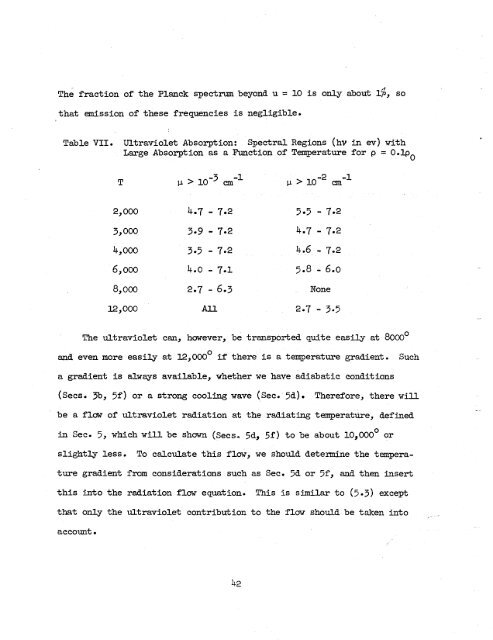Theory of the Fireball
Theory of the Fireball
Theory of the Fireball
You also want an ePaper? Increase the reach of your titles
YUMPU automatically turns print PDFs into web optimized ePapers that Google loves.
The fraction <strong>of</strong> <strong>the</strong> Planck spectm beyond u = 10 is only about Y$, so<br />
that dssion <strong>of</strong> <strong>the</strong>se frequencies is negligible.<br />
Table VII. Ultraviolet Absorption: Spectral Regions { hv in ev) with<br />
Large Absorption as a Function <strong>of</strong> Temperature for p = O.lpo<br />
T I.L > 10-3 LL > m’l<br />
2,000 4.7 - 7.2 5.5 - 7.2<br />
3,000 3.9 . 7.2 4.7 - 7.2<br />
4,000 3.5 - 7.2 4.6 - 7.2<br />
6,000 4.0 - 7.1 5.8 - 6.0<br />
8,000 2.7 - 6.3 None<br />
12,000 All 2.7 - 3.5<br />
The ultraviolet can, hawever, be transported quite easily at 8000~<br />
and even more easily at 12,000° if <strong>the</strong>re is a temperature gradient . Such<br />
a gradient is always available, whe<strong>the</strong>r we have adiabatic conditions<br />
(Secs. 3, 5f) or a strong cooling wave (Sec. 5d) Therefore, <strong>the</strong>re will<br />
be a flow <strong>of</strong> ultraviolet radiation at <strong>the</strong> radiating temperature, defined<br />
in Sec. 5, which will be shown (Secs. 5d, 5f) to be about 10,OOOo or<br />
slightly less. To calculate this flow, we should determine <strong>the</strong> tempera-<br />
ture gradient from considerations such as Sec. 5d or 5f, and <strong>the</strong>n insert<br />
this into <strong>the</strong> radiation fluw equation. This is similar t o (5.3) except<br />
that only <strong>the</strong> ultraviolet contribution to <strong>the</strong> flow should be taken into<br />
account.<br />
42
















